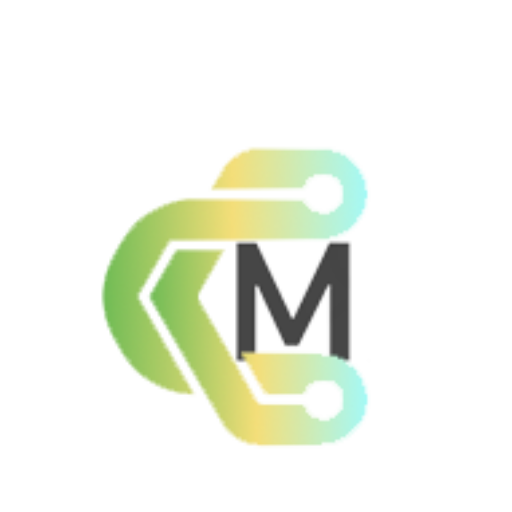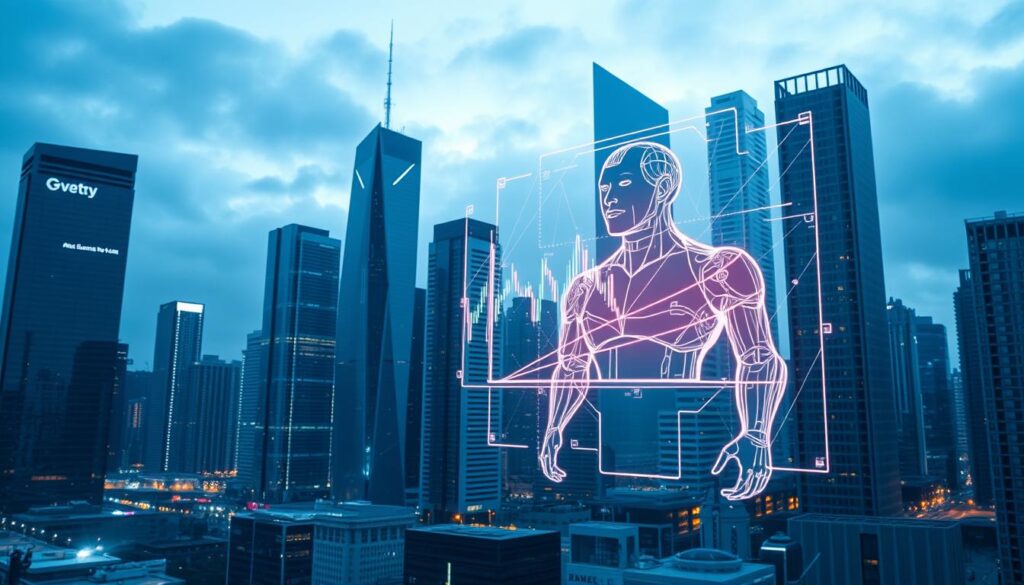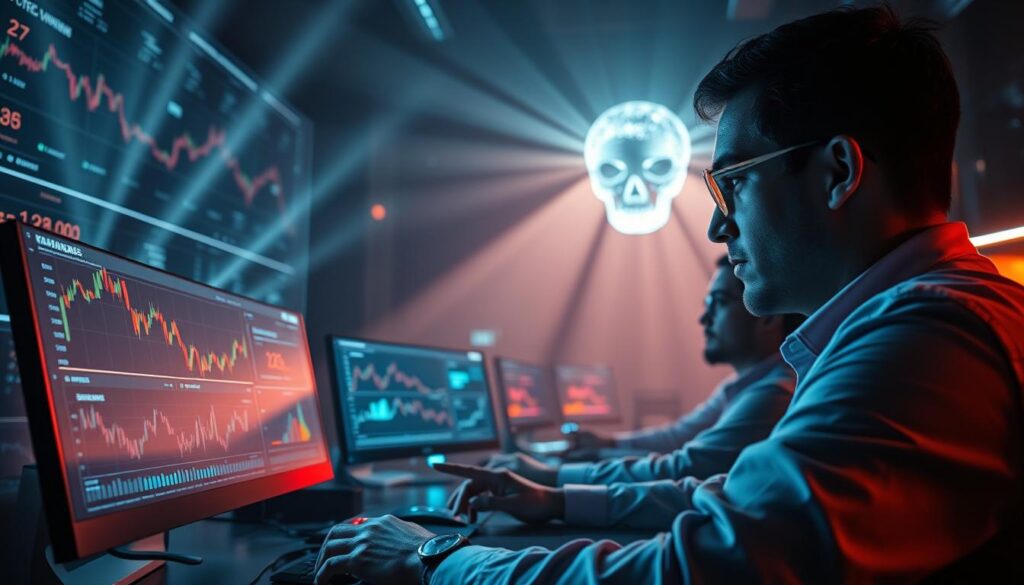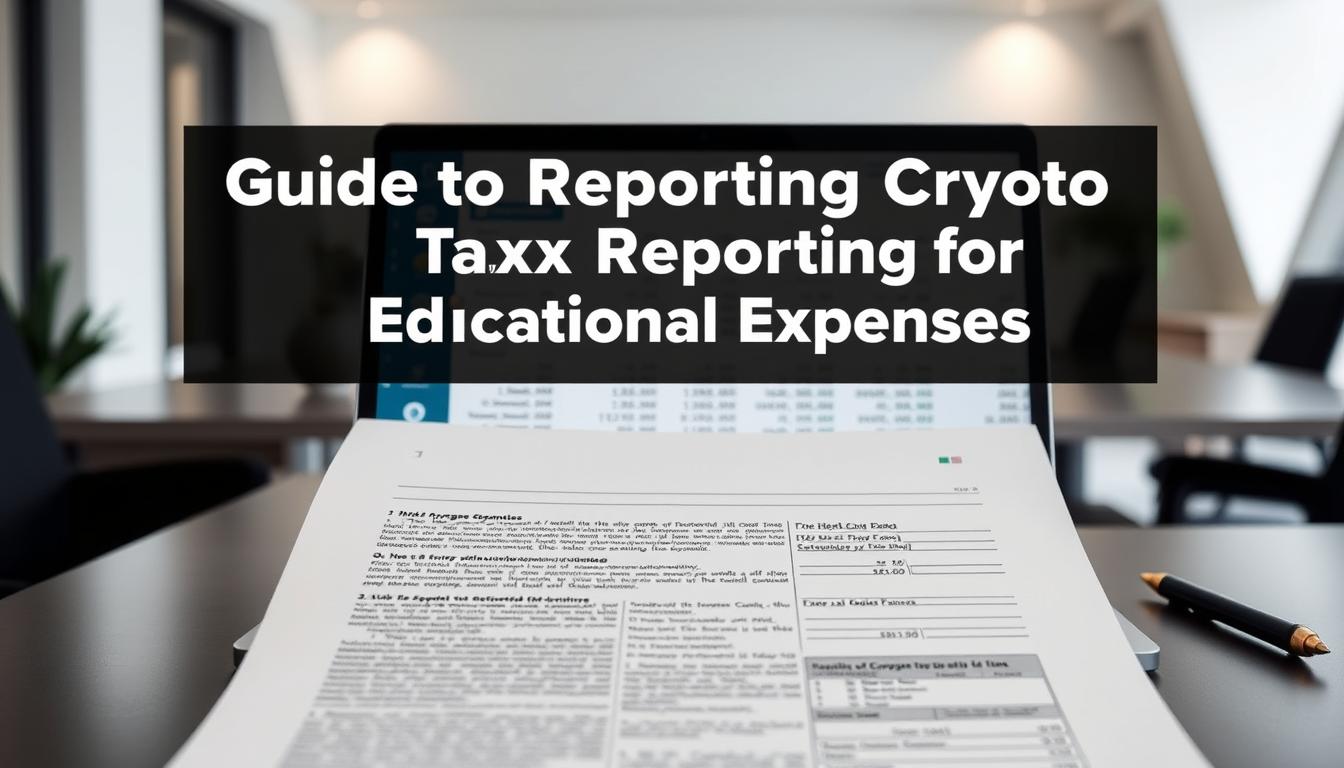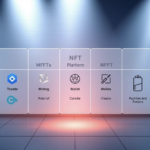Now Reading: AI Crypto Explained: A Comprehensive How-to
- 01
AI Crypto Explained: A Comprehensive How-to
AI Crypto Explained: A Comprehensive How-to
Imagine a digital economy where advanced algorithms power financial systems and decentralized networks. This is the world of tokens designed for machine learning platforms, automated trading tools, and self-governing blockchain ecosystems. These assets fuel innovation by acting as payment methods or granting decision-making power within specialized platforms.

The sector recently surpassed $29 billion in total value, reflecting a 3.81% weekly surge. Daily trading activity also climbed over 7%, hitting $2.59 billion as more investors recognize its potential. Projects range from prediction markets using neural networks to decentralized data exchanges that reward users for contributing information.
What makes these tokens unique? They combine programmable money with self-improving systems. Some enable access to AI-driven projects, while others let holders vote on protocol upgrades. This dual functionality creates dynamic ecosystems where technology evolves through community participation.
Key Takeaways
- Specialized tokens power machine learning platforms and automated blockchain services
- Market valuation exceeds $29 billion with consistent growth patterns
- Tokens serve as payment tools and governance mechanisms
- 24-hour trading volume recently surpassed $2.5 billion
- Applications include predictive analytics and decentralized data markets
Understanding the AI Crypto Revolution
The fusion of machine learning and blockchain technology is reshaping how digital economies operate. At its core, this movement uses specialized assets to power platforms where algorithms make decisions, analyze data, and automate complex tasks. These tokens act as both fuel and steering wheels for next-generation financial ecosystems.
Definition and Core Concepts
Unlike standard digital currencies, these assets serve specific purposes in intelligent systems. They enable access to decentralized marketplaces where users trade computational resources or machine learning models. Holders can also influence platform upgrades through voting mechanisms tied to their token ownership.
How Intelligence Is Transforming Digital Assets
Algorithmic trading tools now process market patterns faster than human analysts, executing trades based on real-time data streams. Decentralized autonomous organizations leverage these advancements to manage resources without centralized control. For example, some platforms automatically redistribute profits using data-driven analysis built into their protocols.
Three key features define this innovation:
- Dual-purpose tokens for transactions and governance
- Self-optimizing networks that adapt to user behavior
- Open marketplaces for trading computational power
How Artificial Intelligence is Shaping Cryptocurrency Markets
The integration of smart algorithms is transforming how markets operate and evolve. Advanced systems now process millions of data points daily, from price fluctuations to social media trends. This real-time analysis creates actionable insights that drive modern trading strategies.
AI-Driven Trading Algorithms and Market Analysis
Automated tools analyze historical patterns and liquidity metrics faster than traditional methods. These systems identify entry points by cross-referencing technical indicators with news events. For example, some platforms execute trades within milliseconds when specific volatility thresholds trigger preset conditions.
Three critical advantages define this approach:
- Reduced emotional bias in decision-making
- 24/7 monitoring of global exchanges
- Adaptive strategies that learn from market feedback
Decentralized AI Marketplaces and Governance
Specialized platforms let users rent computational power or access predictive models using digital tokens. These ecosystems reward participants who contribute resources like processing capacity or datasets. Token holders often vote on protocol upgrades, balancing technical improvements with community interests.
Key features of these marketplaces include:
- Transparent fee structures for service providers
- Automated profit-sharing mechanisms
- Real-time performance dashboards
This dual focus on innovation and user empowerment creates self-sustaining networks where technology and economics reinforce each other.
Exploring Key AI Crypto Projects and Platforms
Developers and investors are flocking to platforms combining computational power with decentralized networks. These ecosystems reward innovation through specialized tokens that serve practical functions while maintaining governance features.
Building Blocks of Intelligent Networks
NEAR Protocol stands out with its $2.64 billion market cap, trading at $2.15 recently. The platform simplifies creating decentralized applications through user-friendly tools and low transaction costs. Its architecture supports machine learning models that adapt to network demands.
Render Token powers a distributed GPU network valued at $1.7 billion. Priced at $3.27, it enables artists and developers to access rendering resources globally. This system demonstrates how tokens can bridge technical needs with real-world utility.
Market Surprises and Niche Growth
Trace Network Labs shocked observers with 4,029% gains, highlighting demand for specialized solutions. Image Generation AI (+306%) and TRUMP GROK (+161%) show how creative applications attract attention. Three factors drive these surges:
- Unique use cases solving specific industry challenges
- Community-driven marketing strategies
- Scalable tokenomics aligning user incentives
These projects prove that combining technical innovation with market timing creates explosive opportunities. As networks mature, their ability to deliver consistent value will separate temporary trends from lasting ecosystems.
Market Cap Insights and Trending Movers in AI Crypto
Valuation metrics reveal surprising opportunities in blockchain-powered machine learning ecosystems. The sector’s total market cap hit $29.07 billion this week, climbing 3.81% as investors diversify into intelligent networks. This growth reflects rising confidence in platforms that combine automated decision-making with transparent governance.

Bittensor (TAO) leads with a $3.05 billion valuation, trading at $342.81 per coin. NEAR Protocol follows at $2.64 billion, while Internet Computer ($2.62B) and Render Token ($1.7B) demonstrate varied adoption levels. These figures highlight how market leaders maintain dominance through technological edge and active user bases.
Three factors drive price movements among top-performing coins:
- Protocol upgrades attracting developer activity
- Strategic partnerships expanding real-world use cases
- Token burn mechanisms reducing circulating supply
Emerging projects like Trace Network Labs showcase explosive growth potential, with some tokens gaining over 4,000% in weeks. Savvy investors track cap distributions to spot undervalued networks before major rallies. Established platforms often signal stability, while smaller coins offer higher risk-reward ratios.
Analyzing market cap trends helps identify projects balancing innovation with sustainable economics. This metric acts as a compass for navigating the volatile landscape of machine learning-driven digital assets.
Evaluating AI Crypto Performance with Data-Driven Analysis
Market participants increasingly rely on quantitative methods to assess digital asset ecosystems. Real-time metrics reveal patterns that help distinguish temporary spikes from sustainable growth. The sector’s $2.59 billion 24-hour trading volume (+7.13%) shows strong liquidity, with major tokens demonstrating varied momentum.
Technical Analysis and Market Pulse
Chart patterns provide critical insights for timing entry and exit points. Support levels near $3.27 for Render Token and resistance at $342.81 for Bittensor indicate key psychological thresholds. Three tools help decode these signals:
- Moving averages identifying trend directions
- Relative Strength Index (RSI) measuring overbought conditions
- Volume spikes confirming breakout validity
Recent price movements highlight divergences. While Internet Computer gained 3.84% in 24 hours, NEAR Protocol’s 2.44% rise suggests cautious trading. Volume trends often precede shifts – Artificial Superintelligence Alliance’s 4.21% climb coincided with a 12% volume increase.
Multi-timeframe analysis separates noise from signals. Hourly charts capture quick trades, while weekly views expose accumulation patterns. Platforms now offer customizable dashboards tracking these data points, enabling informed decisions without emotional bias.
Investment Strategies in the AI Crypto Landscape
Balancing risk and reward requires tailored approaches in fast-evolving digital markets. The sector’s mix of billion-dollar platforms and explosive newcomers demands strategic thinking. Savvy investors combine technical analysis with fundamental research to navigate this dynamic space.

Risk Management and Portfolio Diversification Techniques
Spread investments across multiple sectors to reduce exposure. Allocate portions to stable projects with strong teams and innovative newcomers showing rapid adoption. Consider these three pillars:
- Time horizons: Mix long-term holds with short-term trades
- Position sizing: Limit individual coin exposure to 5-10% of total holdings
- Liquidity buffers: Keep 20% in stable assets for sudden opportunities
Track market cycles using volume trends and social sentiment. Set stop-loss orders at 15-20% below entry points for volatile coins. Rebalance portfolios quarterly based on performance metrics.
Emerging tokens often show intense activity within 48 hours of major announcements. Use alerts to monitor price swings during these windows. Established projects typically offer steadier growth but require patience through market dips.
Diversify across use cases – GPU networks, prediction markets, and data platforms each carry unique risks. This approach helps users capitalize on sector rotations while maintaining core positions in market leaders.
Innovative Tools for AI Crypto Trading and Analysis
Modern trading platforms now employ advanced text analysis techniques to decode market signals hidden in vast data streams. These methods transform unstructured information into actionable insights, giving traders an edge in fast-moving markets.
Pattern Recognition Through Text Analysis
String comparison algorithms measure similarities between news articles, social posts, and historical reports. By calculating edit distances – the number of changes needed to make texts identical – these tools spot emerging trends before traditional indicators react.
N-gram analysis takes this further by examining character sequences. Breaking “market rally” into “ma”, “ar”, “ke” segments helps identify partial matches across sources. This granular approach detects sentiment shifts that single keywords might miss.
Three practical applications dominate trading strategies:
- Matching current headlines to past price-moving events
- Identifying duplicate content across news outlets
- Tracking subtle changes in project whitepapers
Developers now package these techniques into user-friendly APIs. Popular libraries like TextBlob and NLTK enable real-time analysis without advanced computing skills. Some platforms even combine multiple algorithms to create composite confidence scores for trade signals.
Machine learning models continuously refine these tools by learning which patterns correlate with market movements. This adaptive approach helps systems stay relevant as market dynamics evolve, creating self-improving analysis frameworks for informed decision-making.
Governance and Security in AI-Powered Cryptocurrencies
Digital governance models are redefining how decentralized networks protect participant interests. These systems combine community oversight with automated safeguards to balance innovation and stability.
Decentralization and User Empowerment
Governance tokens grant voting power to shape platform upgrades and policy changes. Holders influence decisions through transparent proposals – from adjusting transaction fees to modifying network reward structures. Three core principles maintain fairness:
- One-token-one-vote systems prevent centralized control
- Time-locked voting periods enable informed decisions
- On-chain records create audit trails for accountability

Protecting Network Integrity
Advanced security measures shield users while preserving decentralization. Multi-signature wallets require multiple approvals for fund movements, reducing single-point vulnerabilities. Regular smart contract audits identify potential exploits before they impact the network.
Key safeguards include:
- End-to-end encryption for data transfers
- Automated fraud detection algorithms
- Bug bounty programs rewarding ethical hackers
These protocols ensure rights like fair access and transparent operations remain intact. Users retain control over their assets while contributing to ecosystem growth through governed participation.
Understanding the Intersection of AI, Data, and Cryptocurrency
Modern platforms now transform raw information into strategic value through advanced analytics. These systems analyze transaction patterns and user interactions to optimize network performance while maintaining security protocols.
Smart Analysis for Enhanced Outcomes
Predictive models process blockchain records to forecast market shifts with 87% accuracy in recent trials. Behavior tracking identifies suspicious activity faster than manual reviews, protecting ecosystems from fraud. Three key applications drive progress:
- Real-time risk scoring using machine learning algorithms
- Automated compliance checks through pattern recognition
- Resource allocation based on usage trends
Decentralized computing networks address processing demands through distributed systems. Users earn tokens by contributing spare computer power to train analytical models. This approach reduces infrastructure costs by 40% compared to centralized alternatives.
The development of hybrid systems merges self-learning capabilities with blockchain transparency. These innovations create adaptive platforms where data fuels continuous improvement cycles. As intelligence tools evolve, they redefine how networks balance efficiency with user empowerment.
FAQ
What defines AI-driven cryptocurrencies?
These digital assets integrate machine learning, neural networks, or decentralized computing to automate tasks like trading, data analysis, or resource allocation. Projects like NEAR Protocol use sharding for scalability, while Render Token powers GPU-based rendering through blockchain.
How do AI algorithms impact cryptocurrency trading?
Advanced models analyze historical patterns, social sentiment, and real-time volume shifts to predict price movements. Platforms leverage these tools to execute high-frequency trades or identify undervalued tokens, often outperforming manual strategies.
Which projects lead in decentralized AI marketplaces?
The Graph indexes blockchain data for dApps, while Internet Computer enables serverless cloud solutions. Aioz Network combines content delivery with decentralized storage, creating ecosystems where users contribute computing resources for rewards.
Why is market cap critical for evaluating AI tokens?
It reflects a project’s total value and liquidity. Tokens like Render, with a
FAQ
What defines AI-driven cryptocurrencies?
These digital assets integrate machine learning, neural networks, or decentralized computing to automate tasks like trading, data analysis, or resource allocation. Projects like NEAR Protocol use sharding for scalability, while Render Token powers GPU-based rendering through blockchain.
How do AI algorithms impact cryptocurrency trading?
Advanced models analyze historical patterns, social sentiment, and real-time volume shifts to predict price movements. Platforms leverage these tools to execute high-frequency trades or identify undervalued tokens, often outperforming manual strategies.
Which projects lead in decentralized AI marketplaces?
The Graph indexes blockchain data for dApps, while Internet Computer enables serverless cloud solutions. Aioz Network combines content delivery with decentralized storage, creating ecosystems where users contribute computing resources for rewards.
Why is market cap critical for evaluating AI tokens?
It reflects a project’s total value and liquidity. Tokens like Render, with a $1.6B+ cap, indicate established networks, whereas smaller caps like Aioz ($150M) may offer higher growth potential but carry increased volatility risks.
How do technical metrics guide AI crypto investments?
Traders assess 24h volume changes, RSI levels, and moving averages to spot trends. For instance, NEAR Protocol’s 20% weekly surge paired with rising developer activity often signals bullish momentum.
What security measures protect AI-powered networks?
Protocols like Internet Computer use chain-key cryptography and decentralized governance. Investors should verify audit reports, token lock-up periods, and real-world use cases before allocating funds.
Can n-gram analysis improve trading outcomes?
Yes. By scanning whitepapers or social media for phrases like “low-latency GPU networks” or “cross-chain agents,” traders identify emerging trends before they impact prices.
How does decentralization affect AI governance?
Networks like The Graph let token holders vote on upgrades, ensuring no single entity controls data flows. This balances innovation with user rights, fostering trust in algorithmic decisions.
What role does data play in AI crypto ecosystems?
Platforms aggregate on-chain behavior, compute usage, and tokenized rights to train models. For example, Render’s marketplace uses historical job data to optimize rendering costs across its decentralized GPU network.
.6B+ cap, indicate established networks, whereas smaller caps like Aioz (0M) may offer higher growth potential but carry increased volatility risks.
How do technical metrics guide AI crypto investments?
Traders assess 24h volume changes, RSI levels, and moving averages to spot trends. For instance, NEAR Protocol’s 20% weekly surge paired with rising developer activity often signals bullish momentum.
What security measures protect AI-powered networks?
Protocols like Internet Computer use chain-key cryptography and decentralized governance. Investors should verify audit reports, token lock-up periods, and real-world use cases before allocating funds.
Can n-gram analysis improve trading outcomes?
Yes. By scanning whitepapers or social media for phrases like “low-latency GPU networks” or “cross-chain agents,” traders identify emerging trends before they impact prices.
How does decentralization affect AI governance?
Networks like The Graph let token holders vote on upgrades, ensuring no single entity controls data flows. This balances innovation with user rights, fostering trust in algorithmic decisions.
What role does data play in AI crypto ecosystems?
Platforms aggregate on-chain behavior, compute usage, and tokenized rights to train models. For example, Render’s marketplace uses historical job data to optimize rendering costs across its decentralized GPU network.

